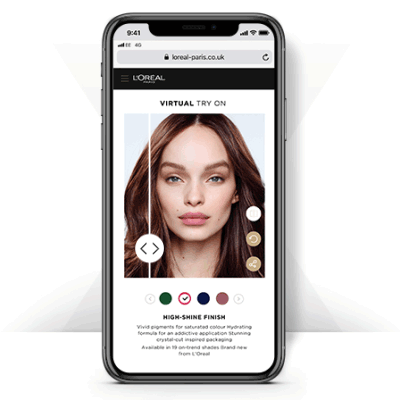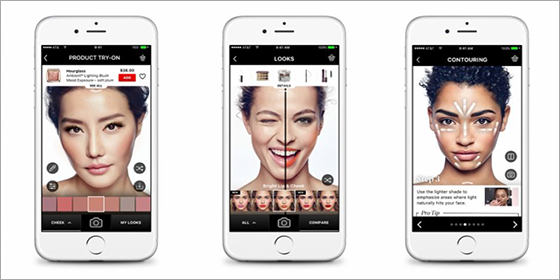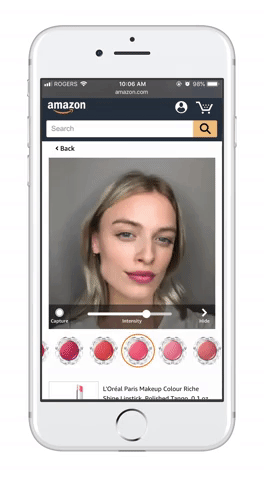L’Oréal Completes Digital Metamorphosis
Many of us have been  L’Oréal customers at some point in our lives. There’s a very high likelihood that you have at least one L’Oréal item in your makeup or grooming product collection right now. As the number one beauty brand in the world, the cosmetic giant’s portfolio includes brands like L’Oréal, Maybelline, Garnier, Essie, Vichy, and The Body Shop—to name a few—offering everything from skin and hair care to make-up and fragrance.
L’Oréal customers at some point in our lives. There’s a very high likelihood that you have at least one L’Oréal item in your makeup or grooming product collection right now. As the number one beauty brand in the world, the cosmetic giant’s portfolio includes brands like L’Oréal, Maybelline, Garnier, Essie, Vichy, and The Body Shop—to name a few—offering everything from skin and hair care to make-up and fragrance.
Digital Metamorphosis
L’Oréal has been taking some ground-breaking steps towards a digital transformation journey guided by Lubomira Rochet, Chief Digital Officer of L’Oréal. The purpose of the consumer delivery overhaul came as a result of a change in customers’ demands. According to Cristina Monnoyeur, Operations Digital Transformation Director at L’Oréal, “the brand's consumers have changed more in the last three to five years than they have in the last 30 years combined. They’re much more eco-conscious; they want more trust and transparency, and they want anything, anytime, anywhere.” Being more highly-developed and digitally efficient was essential in meeting the personalization demands of today’s sophisticated clientele. The digital transformation journey that L’Oréal has embarked on aims to make use of every technology available—such as IoT, Blockchain and AI—and expects to improve performance in every aspect of their business from factory processes to customer interaction. “These innovations—with humans at the center—will not only help us better address our customers’ needs but also make the lives of our employees easier,” said Monnoyeur.
Mme. Rochet has been successful in guiding the brand through the first phase of their revamp, which saw the L’Oreal become a digital-first company. You can read more about the brand’s digital transformation in CMSC Media’s in-depth case study. The driving force in L’Oréal’s second phase of digital evolution to transform the beauty experience will be the deployment of technology such as augmented reality (AR), Voice, and virtual reality (VR). According to Mme. Rochet, their mission is to “recreate trust by putting people and communities at the heart of its marketing activities, and to attract people’s attention by creating the best possible beauty experience and by developing multi-channel services that will appeal to the consumer of the future.”
L’Oréal took a tactical leap into the world of digital by acquiring their first tech company, Toronto based ModiFace, a leader in augmented reality and artificial intelligence. Together, L’Oréal and ModiFace are building innovative technologies that will change the way consumers shop—from virtual makeup and hair color try-on to AI-powered skincare diagnostics and real-time online beauty consultations. The cosmetics superpower hopes that all of these new services will help further personalize relations with their consumers at various touchpoints. According to L’Oréal’s 2018 Annual Report report, eCommerce is an ever-increasing sector for the company, accounting for 11% of group sales and becoming the brand’s ‘second country’ in business terms.

High-Tech Beauty
“Personalization is the name of the game,” said L’Oréal CEO, Jean-Paul Agon, at Viva Technology Paris 2019. During the conference, L’Oréal announced its newest tech innovations in the world of beauty. “New technologies such as Augmented Reality, Artificial Intelligence, and voice, enable us to offer more and more personalized and sophisticated services to all, to produce in a more agile and sustainable way, to integrate our consumers into the creation process and to offer them an experience accessible at any time, everywhere,” said Lubomira Rochet. “A very exciting area of transformation driven by digital technologies is AI and ML. This is a very exciting area of development and investment to build the future L’Oréal as a beauty tech company powered by Data and AI.”
App-lied Beauty
ModiFace is playing a pivotal role in L’Oréal’s vision to bring makeup and hair color try-on, customized AI-powered diagnostics, and real-time beauty consultations to their consumers and they are paving the way for the new digital road in beauty. Thanks to L’Oréal’s Digital Services Factory, the brand has rolled out over 20 ModiFace services in 11 of its brands in over 16 countries.
“Augmented reality and artificial intelligence will unlock significant advantages for L’Oréal’s brands by amplifying digital sales channels, increasing personalisation and consumer engagement, as well as enabling a deeper understanding of consumers. We are delighted to keep pushing the boundary in these exciting directions and to unlock the benefits for L’Oréal’s brands.” — Founder and CEO of ModiFace
Earlier this year, Modiface and L’Oréal Research and Innovation launched their first new skin diagnostic application, Vichy SkinConsult. The technology will help provide men and women ‘tailor-made diagnostics’ and skincare recommendations based on an AI-powered algorithm that uses deep machine learning to asses the skin with a high level of precision. In the same vein, the new La Roche-Posay’s Effaclar Spotscan provides personalized skincare advice for acne-prone skin. The app uses AI and scientific data and was co-developed with dermatologists.
On the make-up side, ModiFace has announced that it will provide its AI-powered technology to Amazon, enabling the eCommerce mogul to offer its first AR make-up try-ons on the platform. “The AR simulation of each shade is done automatically, based on AI-powered analysis of information provided by makeup brands, but also images and descriptions of the product available on social media. The technology is able to analyze textual and visual information related to a particular makeup shade and to realistically reproduce it via Augmented Reality.” L’Oréal is also using technology to help improve not just the customer experience at every touchpoint, but the products themselves by offering customized foundations (Lancome) and personalized serums (SkinCeuticals).
ModiFace is also offering its services to other distributors such as Boots in the UK, Alibaba, and Tencent in China, aiming to help increase conversion rates for the brand. In addition, L’Oréal is scaling ModiFace through all of the brand’s touchpoints; from websites, apps, to POSs, trying an open-source approach by signing deals with Amazon, Facebook, Google Lens, WeChat, and Instagram to embed ModiFace into their technology.
The Future of Beauty
L’Oréal has taken its new digital transformation seriously and seems to have fully immersed itself into this process. They are not afraid to be forward-thinking outside of the box and go above and beyond when it comes to pioneering the use of technology in its industry. They are no longer playing digital catch-up, rather, they are raising the bar—not just for the beauty world, but commerce in general. While the first phase of L’Oréal’s cutting-edge remodeling was much less obvious since it involved digital transformation from within, this second phase of their metamorphosis is downright exciting to watch. The acquisition of ModiFace and the use of AI and AR is breaking physical barriers as well as redefining the whole eCommerce experience. Appreciating just how committed the brand is to state-of-art evolvement, I cannot wait to see what ambitious concepts L’Oréal has forthcoming.

Ellie Somfelean
Ellie is a Reporter and Content Marketer with CMSC Media. She is passionate about social media and digital marketing. She has a vast experience with content creation, influencer marketing and brand promotion.